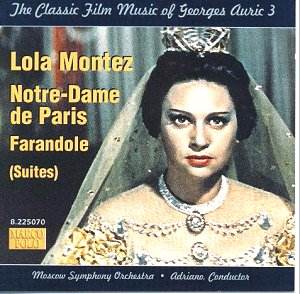Georges AURIC (1899-1983)
Film Music: Lola Montez. Notre-Dame de Paris.
Farandole.
 Moscow Symphony Orchestra
conducted by Adriano
Moscow Symphony Orchestra
conducted by Adriano
 Marco Polo 8.225070
[63:33]
Marco Polo 8.225070
[63:33]
Crotchet

With these three scores Adriano reaches the third volume of film music by
Georges Auric and, for me, it is the best so far in an outstanding series.
In fact, this album is going to be a strong candidate when it comes to Film
Music on the Web Awards for the year 2000.
The most substantial work is the 28-minute suite from Max Ophül's 1955
film of the life of the famous 19th century femme fatale
- Lola Montez (1818-1861). This beautiful woman
of Irish extraction had toured Europe as a dancer and acted as a political
spy. Her conquests included Franz Liszt, Fréderic Chopin, Prosper
Merimée, Alexander Dumas senior and King Ludwig I of Bavaria. Her
life ended as a religious recluse but not before she had sunk to appearing
as a circus act when her fortunes fell. It is this circus presence that is
a strong feature of the film with the cynical ringmaster (Sir Peter Ustinov)
exposing her loves and her shame.
The Main Title opens on a dramatic note with military material reminding
us of the significance of Lola's spying activities. This soon segues into
one of the waltzes that dominate the score. This one is slow and sombre and
is associated with Lola's failed and lonely existence as a circus 'freak'
and, indeed, the music then soon becomes circus orientated, colourful and
vibrant but with a cheap brassy feel heightened by the use of a chorus of
five saxophones. In sharp contrast 'Lola's childhood and youth' is a charming
picture of youthful games and high spirits, Auric delightfully capturing
the essence of a frolicsome little girl but there is pathos too in the material
that underlines the disturbed relationship between Lola and her frivolous
mother.
The 'Farewell Waltz' is one of Auric's best-loved melodies (composed in the
film by Liszt as a farewell present to Lola after their affair) and it is
given two separate cues in this suite. The first begins with snare drums
marking a strict tempo before the mood relaxes and the melody proceeds as
a dreamy solo for piano (a beautiful, sensitive rendering by Stos Zabavnikov).
The second cue takes up this dreamy romantic view of the tune and spins out
its romantically yearning qualities.
Elsewhere Auric's versatility is shown in a number of vignettes: short tunes
and dances, or character pieces, suggestive of the countries where her romantic
adventures are set. There is much humour evident: 'Cossacks', for instance,
is a bright, light-hearted confection with the saxophones prominent, leaning
towards Satie; while the four square Germanic 'Minuet' seems more suited
to the beer garden. There is also a colourful and intoxicating 'Fandango'.
Notre Dame de Paris was the 1956 French Technicolor remake of The
Hunchback of Notre Dame. Vilified by the critics, it miscast Anthony
Quinn as Quasimodo and Gina Lollobrigida as the gypsy girl Esmerelda. It
was not a patch on the two earlier Hollywood productions, particularly William
Dieterle's excellent version that starred Charles Laughton as the hunchback.
The one bright element in the 1956 debacle was Auric's score.
The Main Title music begins imposingly with a peal of big bells supported
by massive cymbal and tam-tam crashes that herald majestic awesome music
for the huge edifice that is the Parisian church of Notre Dame. More intimate
romantic music led by flute follows plus murkier material that is the 'Destiny'
theme. 'The March of the Vagabonds' that immediately follows, is swaggeringly
defiant and trenchant - snare drums and trumpets to the fore. Auric is a
master in simultaneously conveying multiple strands of character and plot.
In 'The tryst - the assassination attempt' there is the lyrical tender music
for the romance between Esmerelda and Phoebus counterpointed by the most
odious figures for the jealous onlooking Frollo. His jealousy also blights
another musically complex episode where Quasimodo's unrequited love for Esmerelda
is expressed as he offers her flowers while she is apprehensive fearing Frollo's
malevolence.
Much of the film's score comprised songs and dances for Esmerelda by Francesco
Lavagnino but Auric was also called upon to write a few additional dance
pieces in the ancient style for an ensemble of two harps, two guitars and
cello. These also underscored various scenes involving the hustle and bustle
of the Beggars of Paris. Five of these dance movements are gathered to form
a separate little suite including two lively fandangos and a 'Jota et Habanera'.
Concluding the collection is music from Farandole (1944), an earlier
version of Roger Vadim's celebrated La Ronde. It was about
a circle of illicit love affairs - one person loving someone that loved someone
else until a complicated circle is closed, the last person involved having
an affair with the first.
The music begins somewhat ominously as though self-righteously censoring
the lewd activities to follow but soon this mood gives way to the dizzy whirl
of the love carousel; frivolous and comedic and ending by cocking a snook
at the puritan attitude of its opening. Auric again shows he has a real flair
for comedy with coquettish strings, lustful brass and furtive woodwinds etc.
- this score is a charming soufflé with Poulenc-like insouciance rubbing
shoulders with more romantic reveries.
An outstanding album; heartily recommended.
Reviewer
Ian Lace

